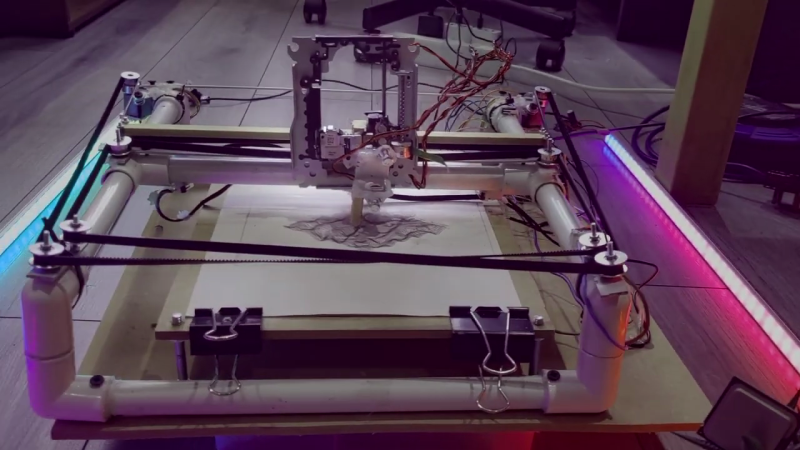[Arca] sets out to build himself a low-cost pen plotter that doesn’t require access to a 3D printer. The plotter uses a coreXY arrangement, powered by 28BYJ-48 stepper motors, which he overdrives with +12 VDC to increase the torque. Pen up and down control is done using a stepper motor salvaged from a DVD reader. The frame is constructed using PVC electrical conduit and associated fittings, and [Arca] uses the hot glue gun quite liberally. Steppers were driven by A4988 modules with heatsinks, and motion control is provided by GRBL running on an Arduino UNO.
He has a few issues with glitches on the limit switches, and is continuing to tweak the design. There is no documentation yet, but you can discern the construction easily from the video if you want to try your hand at making one of these. This is a really cool DIY plotter, and many parts you probably have laying around your parts boxes. As [Arca] says, it’s not an AxiDraw, but the results are respectable. Keep a lookout for part 2 of this project on his YouTube channel.















Great work for a very low cost plotter!
I have a zero cost suggestion that should improve its performance a little, depending on what you’re trying to draw: rearrange the pulleys to keep the belts parallel to the guide rails. That way, belt tension won’t vary as the pen carriage moves and precision and accuracy will improve.
Low pass rc filter on the limit switches, i added them to my CNC, with a grbl uno. Issues before, none after. 1k 3uF if I recall
I’m wondering if thin wall metal electrical conduit, EMT in North America, would be worth considering? Seems like it would be more rigid but corner joints maybe less so.
And Fiberglass the corners
If it’s low friction then why not
Good idea. Maybe run a long bolt through both conduits at the corners to act as gussets. Not an easy set of holes to drill, depending on your equipment, but not impossible. If you want to get fancy, you could cut notches and make wide, rectangular washers to distribute the load better.
If you want more rigidity just fill it with concrete.
Wouldn’t that be quite difficult to cut?
A good frame material for this would,be celulose lignin laminate,comes in many sizes,and is easily shapable and joined into assemblies
Is that the same as Micarta?
For once, username does not check out
Uh, wood?
Excellent work! Making and hacking doesn’t have to cost a gazzion bucks.
Electrical conduit isn’t white and doesn’t have sharp 90s. Looks like plumbing PVC pipe.
EMT conduit would be better. Only a few cents more. However you would need to bend the EMT.
@Lee, not sure where you live, but here in South Africa, electrical conduit is made from white PVC, and is, well, white!
https://www.builders.co.za/Electrical/PVC-Conduit/Builders-PVC-Conduit-4m-20mm/p/000000000000036017
Here is the US it’s gray thick wall PVC known as schedule 40. The outter diameter is different so you can’t use any other types of PVC.
https://www.borderstates.com/All-Products/Conduit-Cable-Management/Conduit-Conduit-Supports-Fittings/Conduit/PVC-Conduit/Generic-Brand-Sch-40-PVC-Conduit/Generic-Brand-Sch-40-PVC-Conduit-4-in-10-ft/p/2243878
White PVC is water, purple is for irrigation.
Thanks @Lee, always nice to get a different perspective from the other side of the planet 👍🏽
You’re right about the hard 90 degree bends though – would be hard to get a fish wire through those, but I think they are available.
Anyways – I love the idea of using electrical conduit for the frame of the plotter!
Here in Australia, electrical conduit is supposed to be orange. To help distinguish it when you go digging.
Irrigation and drainage (rain water) are white, and a purple pipe carries recycled water – great for gardens but not suited for drinking.
Do you assume that the black wire is always live too? US standards are not global.
My local electrical wiring stockist has plastic conduit in white and black / 20mm and 25mm sizes.
https://www.tlc-direct.co.uk/Main_Index/Conduit_Pvc_Index/s/index.html
Both swept and sharp bends are available. The bends have an access panel in the side to assist with wire running.
White electrical conduit is a thing in the UK where I live (https://www.diy.com/departments/mk-pvc-white-conduit-length-l-2m-dia-20mm/109150_BQ.prd). The 90 degree bends are for 20-21mm PVC plumbing so it fits with some hot glue. It’s on a whole new level of jank
I used Ikea curtain rails and cutting board.
Ikea is a fairly cheap source of stainless-steel tubing which happens to be open on a Sunday.
They call it Grundtal and it comes in 600mm lengths in a pack of 6 for £12. It has handy threaded (axial) holes in the end too.
I once mis-assembled a Grundtal shelf into a TV wall mount.